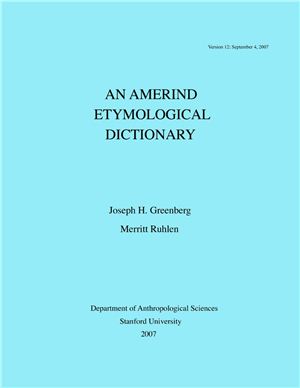2007, Department of Anthropological Sciences - Stanford University,
311p.
This volume presents the lexical and grammatical evidence that defines the Amerind linguistic family. The evidence is presented in terms of 913 etymologies, arranged alphabetically according to the English gloss. Each etymology begins with the English gloss followed by a hypothetical phonetic form from which the individual Amerind forms are presumed to have derived. Within the body of each etymology the evidence is arrayed in terms of the thirteen branches of Amerind in a roughly north to south (or sometimes west to east) order: Almosan, Keresiouan, Penutian, Hokan, Central Amerind, Chibchan, Paezan, Andean, Equatorial, Macro-Tucanoan, Macro-Carib, Macro-Panoan, Macro-Ge.
This volume presents the lexical and grammatical evidence that defines the Amerind linguistic family. The evidence is presented in terms of 913 etymologies, arranged alphabetically according to the English gloss. Each etymology begins with the English gloss followed by a hypothetical phonetic form from which the individual Amerind forms are presumed to have derived. Within the body of each etymology the evidence is arrayed in terms of the thirteen branches of Amerind in a roughly north to south (or sometimes west to east) order: Almosan, Keresiouan, Penutian, Hokan, Central Amerind, Chibchan, Paezan, Andean, Equatorial, Macro-Tucanoan, Macro-Carib, Macro-Panoan, Macro-Ge.

